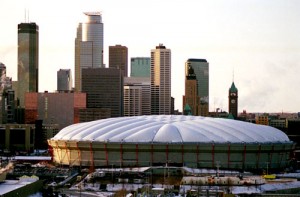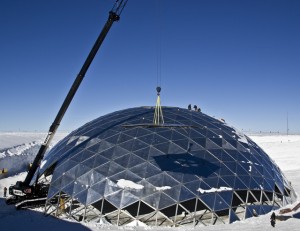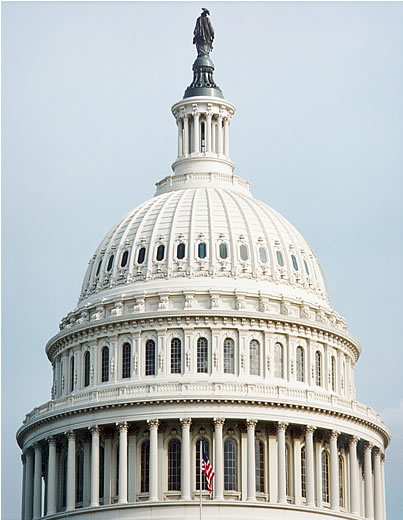Activity: Design a Super Dome
 Lesson adapted from IEEE’s TryEngineering.org. Click here for pdf version of this activity.
Lesson adapted from IEEE’s TryEngineering.org. Click here for pdf version of this activity.
Grade Level: 3 – 12
Time: One or two 45-minute periods
Summary
In this activity, student teams learn about construction and engineering design by building a domed structure with an internal frame that is strong enough to support 120 grams of coins or candy on top. They present their domes to the class and complete reflections on the lessons learned.
Learning Objectives
After doing this activity, students should develop an understanding of:
- The engineering design and redesign process
- Construction techniques
- Teamwork and problem solving
Standards
National Science Education Standards
CONTENT STANDARD A: Science as Inquiry
As a result of activities, all students should develop
- Abilities necessary to do scientific inquiry [K-8]
- Understanding about scientific inquiry [K-12]
CONTENT STANDARD B: Physical Science
As a result of the activities, all students should develop an understanding of
- Properties of objects and materials [K-4]
- Motions and forces [5-12]
CONTENT STANDARD E: Science and Technology
As a result of activities, all students should develop
- Abilities of technological design [K-12]
- Abilities to distinguish between natural objects and objects made by humans [K-4]
- Understanding about science and technology [5-12]
CONTENT STANDARD F: Science in Personal and Social Perspectives
As a result of activities, all students should develop an understanding of
- Types of resources [K-4]
- Changes in environments [K-4]
- Science and technology in local challenges [K-4]
- Science and technology in society [5-8]
- Science and technology in local, national, and global challenges [9-12]
CONTENT STANDARD G: History and Nature of Science
As a result of activities, all students should develop understanding of
- Science as a human endeavor [K-12]
- Science and technology in society [K-4]
- History of science [5-8]
- Historical perspectives [9-12]
Standards for Technical Literacy [K-12]
Technology and Society Standard 6: Students will develop an understanding of the role of society in the development and use of technology.
Design
Standard 8: Students will develop an understanding of the attributes of design.
Standard 9: Students will develop an understanding of engineering design.
Standard 10: Students will develop an understanding of the role of troubleshooting, research and development, invention and innovation, and experimentation in problem solving.
Abilities for a Technological World
Standard 11: Students will develop abilities to apply the design process.
The Designed World
Standard 20: Students will develop an understanding of and be able to select and use construction technologies.
Common Core State Mathematical Standards
Reason with shapes and their attributes. [Grade 3 geometry
- CCSS.Math.Content.3.G.A.1 Understand that shapes in different categories (e.g., rhombuses, rectangles, and others) may share attributes (e.g., having four sides), and that the shared attributes can define a larger category (e.g., quadrilaterals). Recognize rhombuses, rectangles, and squares as examples of quadrilaterals, and draw examples of quadrilaterals that do not belong to any of these subcategories.
Solve real-world and mathematical problems involving area, surface area, and volume. [Grade 6 geometry]
- CCSS.Math.Content.6.G.A.1 Find the area of right triangles, other triangles, special quadrilaterals, and polygons by composing into rectangles or decomposing into triangles and other shapes; apply these techniques in the context of solving real-world and mathematical problems.
- CCSS.Math.Content.6.G.A.3 Draw polygons in the coordinate plane given coordinates for the vertices; use coordinates to find the length of a side joining points with the same first coordinate or the same second coordinate. Apply these techniques in the context of solving real-world and mathematical problems.
- CCSS.Math.Content.6.G.A.4 Represent three-dimensional figures using nets made up of rectangles and triangles, and use the nets to find the surface area of these figures. Apply these techniques in the context of solving real-world and mathematical problems.
Draw construct, and describe geometrical figures and describe the relationships between them. [Grade 7 geometry]
- CCSS.Math.Content.7.G.A.1 Solve problems involving scale drawings of geometric figures, including computing actual lengths and areas from a scale drawing and reproducing a scale drawing at a different scale.
- CCSS.Math.Content.7.G.A.2 Draw (freehand, with ruler and protractor, and with technology) geometric shapes with given conditions. Focus on constructing triangles from three measures of angles or sides, noticing when the conditions determine a unique triangle, more than one triangle, or no triangle.
Solve real-life and mathematical problems involving angle measure, area, surface area, and volume. [Grade 7 geometry]
- CCSS.Math.Content.7.G.B.4 Know the formulas for the area and circumference of a circle and use them to solve problems; give an informal derivation of the relationship between the circumference and area of a circle.
- CCSS.Math.Content.7.G.B.6 Solve real-world and mathematical problems involving area, volume and surface area of two- and three-dimensional objects composed of triangles, quadrilaterals, polygons, cubes, and right prisms.
Apply geometric concepts in modeling situations [High school geometry]
- CCSS.Math.Content.HSG-MG.A.1 Use geometric shapes, their measures, and their properties to describe objects (e.g., modeling a tree trunk as a cylinder).
- CCSS.Math.Content.HSG-MG.A.3 Apply geometric methods to solve design problems (e.g., designing an object or structure to satisfy physical constraints or minimize cost).
Engineering motivation 
Domes, those curved structures that cover some of man’s most important buildings, are sometimes called “the kings of all roofs.” They offer strength, stiffness, and thinness, and because domes enclose a vast space without a single column or corner, domes often top sports stadiums, capitols, and cathedrals alike. Sometimes, disaster strikes even the sturdiest engineering, however. Case in point: The riveting 2010 collapse of the Minnesota Metrodome’s snow-laden inflatable roof.
 Geodesic domes, like the one housing Spaceship Earth at Disney’s Epcot Center, are great examples of structures that require framing to provide shape and strength before an outer shell is created. Its latticed shell is based on a network of great circles (geodesics) lying on the surface of a sphere. The geodesics intersect to form triangular elements that have local triangular rigidity and also distribute the stress across the entire structure. German engineers developed what is considered the first geodesic dome in 1923, more than 20 years before Buckminster Fuller reinvented and popularized this design.
Geodesic domes, like the one housing Spaceship Earth at Disney’s Epcot Center, are great examples of structures that require framing to provide shape and strength before an outer shell is created. Its latticed shell is based on a network of great circles (geodesics) lying on the surface of a sphere. The geodesics intersect to form triangular elements that have local triangular rigidity and also distribute the stress across the entire structure. German engineers developed what is considered the first geodesic dome in 1923, more than 20 years before Buckminster Fuller reinvented and popularized this design.
See page 4 of the Design a Dome .pdf for examples of how domes are used and structures with interesting framing, such as the Statue of Liberty.
Materials
Provide each team with a range of materials, including but not limited to:
- Cardboard
- Wooden dowels
- Tape
- Foil
- Construction paper
- Tissue paper
- Glue
- String
- Rubber bands
- Wire
- Popsicle sticks
- Paper cups
- Straws
- Pipe cleaners
- Paper clips
- Screen
- Fabric
Procedure
1. Have students read (in class or as prior night’s homework) about domes and framing structures on page 4 of the Design a Dome .pdf, or other reference information, such as the Buckminster Fuller Institute.
2. Introduce the lesson by discussing the wide range of shapes and sizes of buildings and have the class consider the advantages or disadvantages of different shapes. Discuss the geodesic dome and have the group consider why domes can be a good shape for some projects and environments; examples include the South Pole dome and dome-design camping tents.
3. Break students into teams and explain the design challenge: As part of a team of engineers, you must build a dome to hold 120 grams of coins, candy, or other materials. The structure must be at least 14 cm tall measured from the apex of the dome to the bottom. Think about the different ways you can use the materials to construct the dome’s
structure. You can add a skin or shell out of different materials, or have the frame be the full product.
4. Have students draw a diagram of their planned domes. (See worksheet, page 5 of the .pdf) and list the parts they think they might need. (They can adjust this later and also add more materials during construction.)
5. Have teams construct their domes with the requested materials list. Teams may request additional materials during the construction process or may trade materials with other student teams.
6. Have teams suspend their dome on strings provided by the teacher, observe other dome designs, and score their own work.
7. Place domes on table and load with 120 grams (4.23 ounces) of candy, pennies, or other weights. Since U.S. pennies minted after 1982 weigh 2.5 grams, put 48 pennies one by one on the dome until it collapses.
8. Have student teams complete a reflection sheet (page 6 of the .pdf) and share their experiences with the class.
Activity scaling
- Younger students can design domes from gum drops and toothpicks. (See PBSKids’ Zoom Into Engineering .pdf)
- For older students, limit the materials each team can use by, for example, pricing each commodity and limiting the project’s budget.
Resources 
Dome basics from PBSKids offers history and fun facts of dome building and domed structures. The U.S. Capitol dome, built in 1793, for instance, gets its height from engineering sleight of hand: The large outer dome is a thin shell, held up curved iron ribs that tops a smaller dome visible only from inside.
PBS’s Building Big website includes links to the Astrodome and other wonders of architecture, a materials primer, a video with a master dome-builder, and lots of fun facts – such as the Georgia Dome stadium being the world’s largest cable-supported dome covered in fabric.
Examples of domes and shells, including modern churches and retractable roofs, from Berkeley’s structural engineering slide library.
How Stuff Works offers a look at the geometry and engineering of why geodesic domes are so strong.
Filed under: Class Activities, Grades 6-8, Grades 9-12, Grades K-5
Tags: Civil Engineering, Class Activities, construction, Dome, Football, Grades 6-8, Grades 9-12, Grades K-5, stadium








